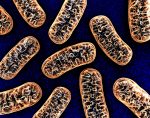Black Pepper Compound May Help Restore Mitochondria in CMT2A
Written by |

Piperine — the molecule that gives black pepper its pungent odor — and other chemically similar compounds can enhance cellular processes whose dysfunction are thought to underlie Charcot-Marie-Tooth disease type 2A (CMT2A), a study has found.
In their ability to enhance the function of mitochondria — which produce energy for cells — such compounds may be promising for the treatment of CMT2A and other diseases marked by mitochondrial dysfunction, the researchers said.
The study, “Piperine Derivatives Enhance Fusion and Axonal Transport of Mitochondria by Activating Mitofusins,” was published in Chemistry.
Mitofusins are proteins involved in mitochondrial fusion, a reparative process by which mitochondria act to preserve function under cellular stress.
CMT2A is a form of Charcot-Marie-Tooth disease caused by mutations in the MFN2 gene which gives instructions for making the mitofusin 2 protein. CMT2A is thought to arise from impaired mitochondrial fusion and a reduced ability for the mitochondria to move as necessary. As a result, mitochondria are abnormally short and have lower motility.
Medications which act to enhance mitofusin activation and mitochondrial fusion could be promising treatments for CMT2A, but are currently lacking, researchers say.
What is piperine?
Present in multiple peppers and ginger, piperine is widely used in traditional medicine practices for a range of health problems. While its therapeutic mechanisms have been underexplored, studies have found it can exert effects on mitochondrial function, and that molecules with a similar chemical structure are involved in mitofusin-mediated mitochondrial fusion.
To learn more, researchers evaluated whether piperine can similarly stimulate mitofusin activity. Cultured cells lacking either mitofusin 1 or 2 show impairments in mitochondrial fusion, including shortened mitochondria. When incubated with piperine, the mitochondria were elongated, indicating the treatment had enhanced mitochondrial fusion processes.
When both mitofusin 1 and 2 were lacking in the cells, piperine could no longer enhance mitochondrial fusion, suggesting that its effects are dependent on the presence of mitofusins.
The team synthesized piperine analogs — chemical compounds with a similar structure and expected function — in the lab. The analogs were designed to optimize mitofusin activation.
Like piperine, these analogs were able to stimulate mitochondrial elongation in cells lacking mitofusin 2.
When placed into cell cultures with neurons from a mouse model of CMT2A, two compounds enhanced mitochondrial motility. When evaluated in the sciatic nerve — the body’s largest nerve that runs down the leg — from the mouse model, one of the compounds successfully improved mitochondrial transport.
The findings overall support the potential for piperine-like compounds to enhance mitochondrial fusion and motility, a mechanism which could benefit CMT2A patients, the researchers noted.
“In addition to providing a plausible mechanism for mitochondrial and metabolic effects of piperine, the discovery that piperine and other piperidine compounds act as potent mitofusin activators is a foundational observation that can help establish a chemical framework for the possible development of novel mitofusin activators with new pharmaceutical properties,” the researchers wrote.
“While CMT2A is the prototypical human disease caused by mitochondrial dynamic dysfunction, it is worth considering other applications for mitofusin activators,” they wrote, adding that people with other diseases, such as Huntington’s disease, might also benefit from this class of compounds.







